India and China's Economic Development
VerifiedAdded on 2020/02/05
|10
|3088
|27
Report
AI Summary
This report provides a comparative analysis of the economic and social changes in India and China since the 1950s. It examines the challenges faced by both nations in the initial years, including economic instability, population growth, and the aftermath of war. The report then delves into the economic and political reforms implemented in both countries over the past six decades. For China, this includes the impact of the Communist Party's policies on industrialization, agriculture, foreign trade, and energy resources. For India, the report highlights the industrial revolution, the shift from a license-based economy to liberalization, privatization, and globalization, and the changes in agriculture and social structures. The report concludes by comparing the outcomes of these reforms, noting that while both nations have achieved significant progress, China has arguably achieved greater results due to its stronger economic policies and manufacturing capabilities. The report uses various academic sources to support its analysis.
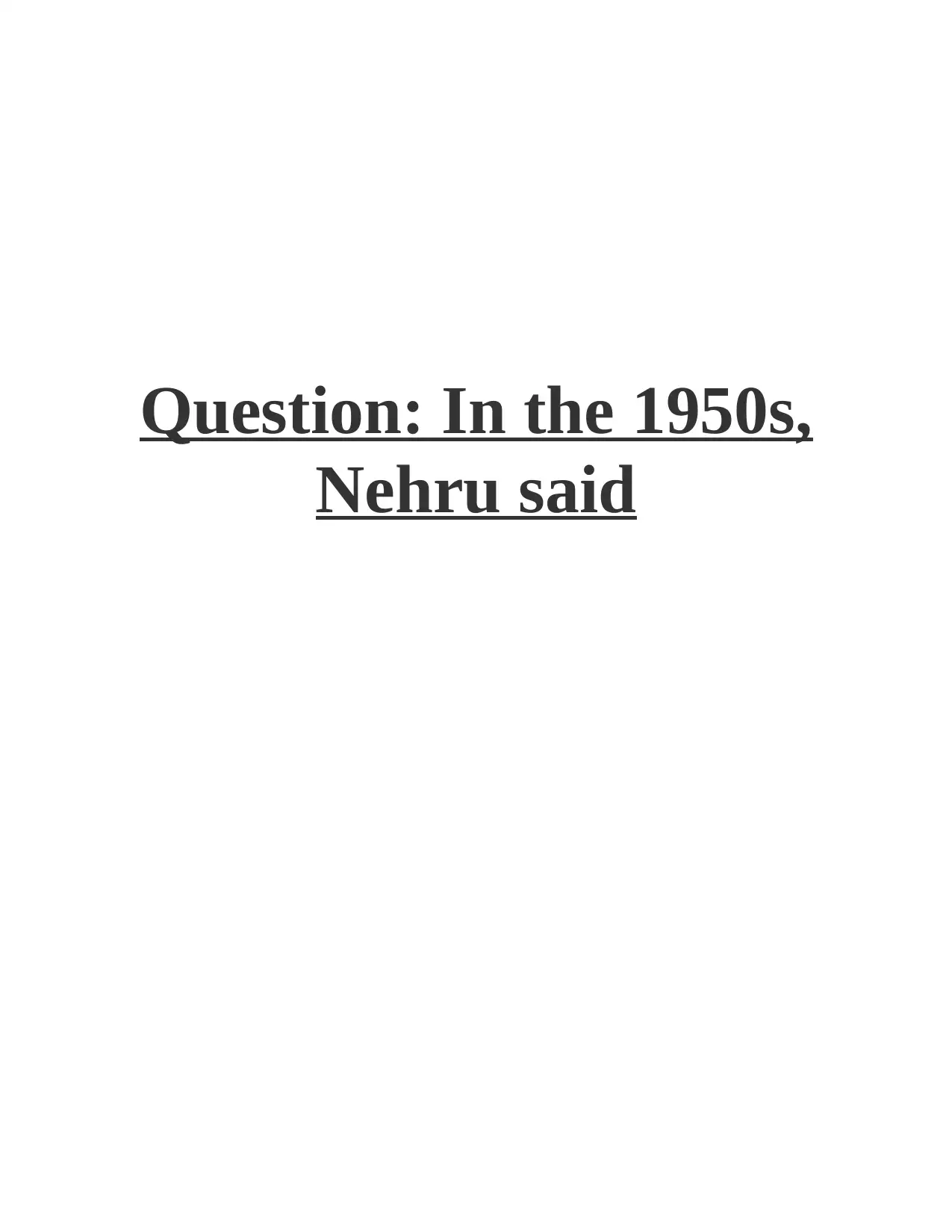
Question: In the 1950s,
Nehru said
Nehru said
Paraphrase This Document
Need a fresh take? Get an instant paraphrase of this document with our AI Paraphraser
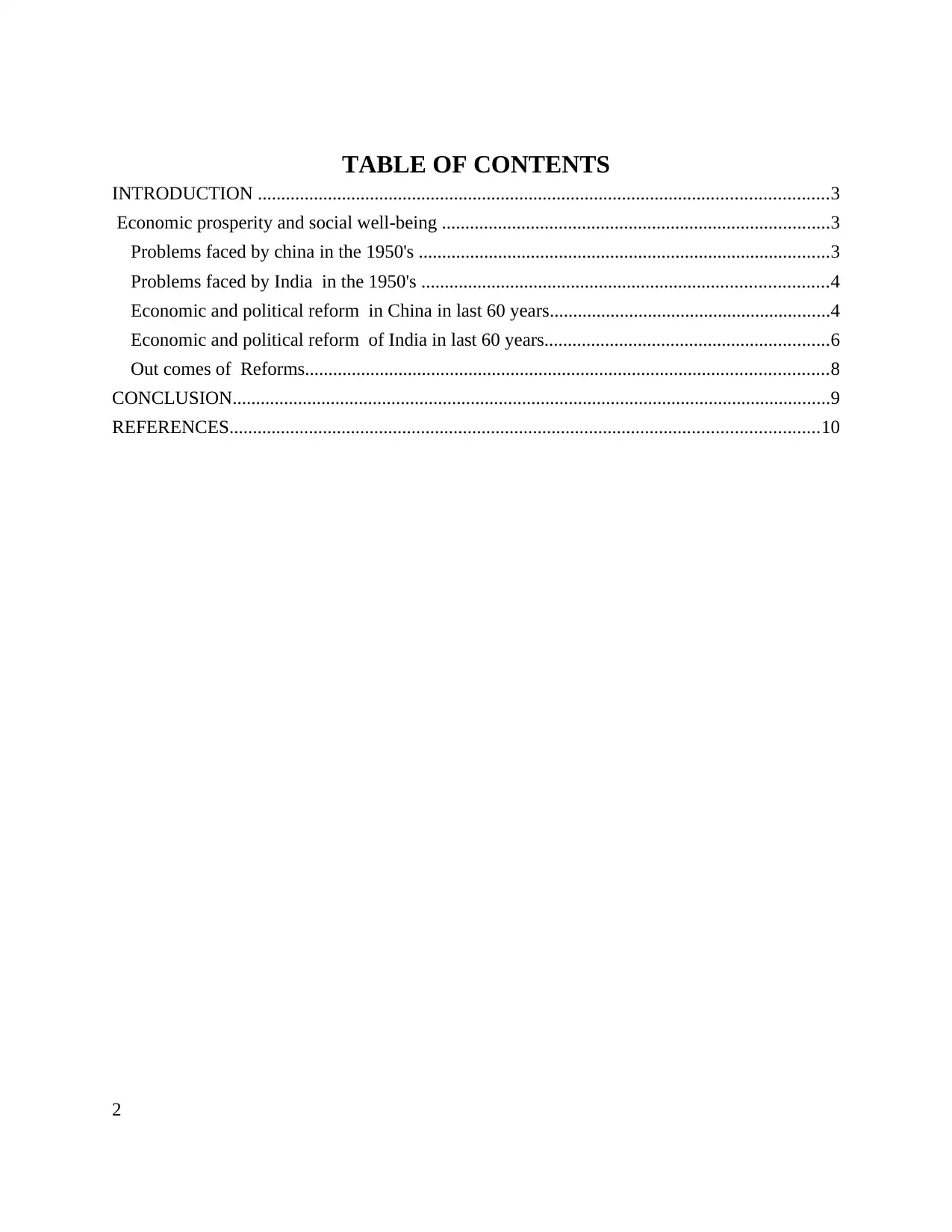
TABLE OF CONTENTS
INTRODUCTION ..........................................................................................................................3
Economic prosperity and social well-being ...................................................................................3
Problems faced by china in the 1950's ........................................................................................3
Problems faced by India in the 1950's .......................................................................................4
Economic and political reform in China in last 60 years............................................................4
Economic and political reform of India in last 60 years.............................................................6
Out comes of Reforms................................................................................................................8
CONCLUSION................................................................................................................................9
REFERENCES..............................................................................................................................10
2
INTRODUCTION ..........................................................................................................................3
Economic prosperity and social well-being ...................................................................................3
Problems faced by china in the 1950's ........................................................................................3
Problems faced by India in the 1950's .......................................................................................4
Economic and political reform in China in last 60 years............................................................4
Economic and political reform of India in last 60 years.............................................................6
Out comes of Reforms................................................................................................................8
CONCLUSION................................................................................................................................9
REFERENCES..............................................................................................................................10
2
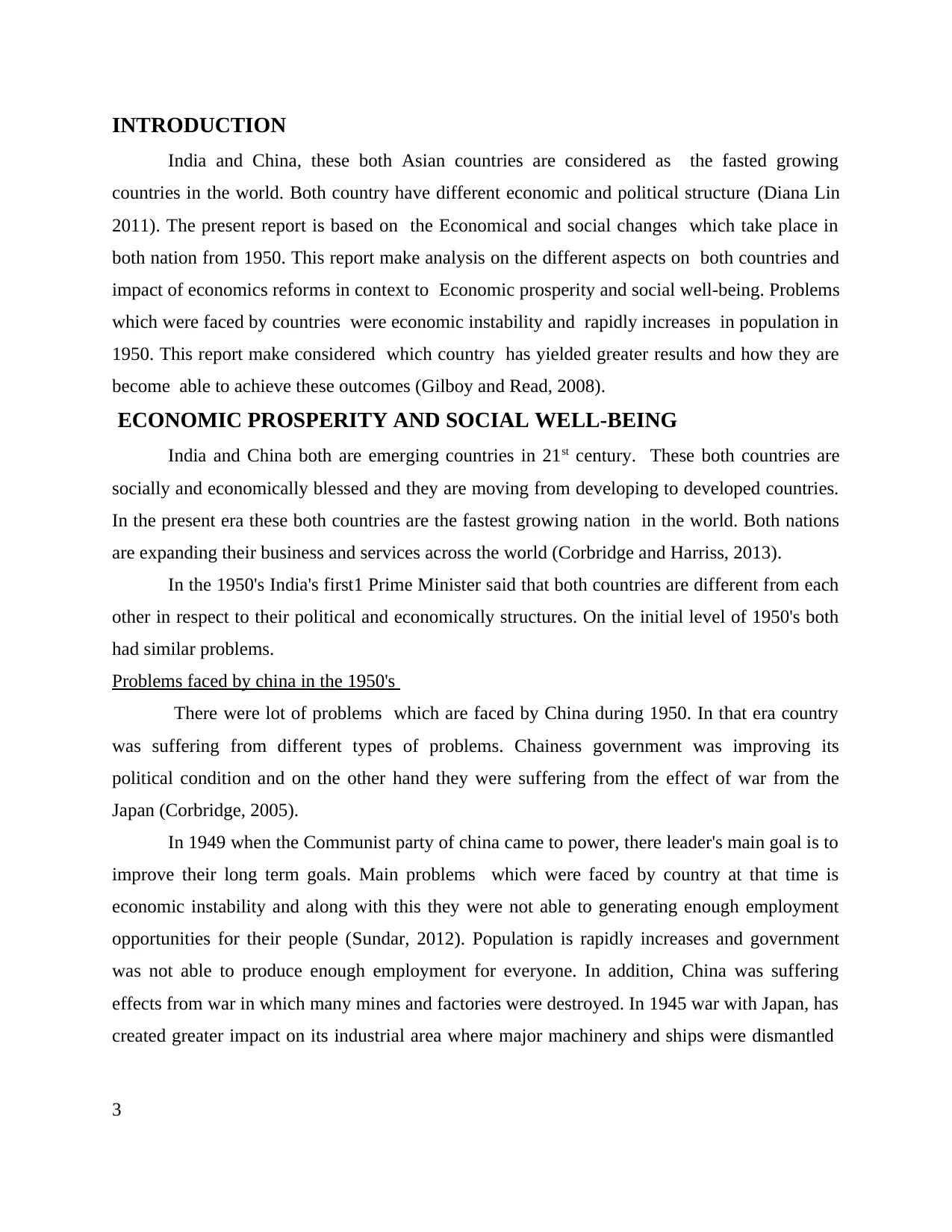
INTRODUCTION
India and China, these both Asian countries are considered as the fasted growing
countries in the world. Both country have different economic and political structure (Diana Lin
2011). The present report is based on the Economical and social changes which take place in
both nation from 1950. This report make analysis on the different aspects on both countries and
impact of economics reforms in context to Economic prosperity and social well-being. Problems
which were faced by countries were economic instability and rapidly increases in population in
1950. This report make considered which country has yielded greater results and how they are
become able to achieve these outcomes (Gilboy and Read, 2008).
ECONOMIC PROSPERITY AND SOCIAL WELL-BEING
India and China both are emerging countries in 21st century. These both countries are
socially and economically blessed and they are moving from developing to developed countries.
In the present era these both countries are the fastest growing nation in the world. Both nations
are expanding their business and services across the world (Corbridge and Harriss, 2013).
In the 1950's India's first1 Prime Minister said that both countries are different from each
other in respect to their political and economically structures. On the initial level of 1950's both
had similar problems.
Problems faced by china in the 1950's
There were lot of problems which are faced by China during 1950. In that era country
was suffering from different types of problems. Chainess government was improving its
political condition and on the other hand they were suffering from the effect of war from the
Japan (Corbridge, 2005).
In 1949 when the Communist party of china came to power, there leader's main goal is to
improve their long term goals. Main problems which were faced by country at that time is
economic instability and along with this they were not able to generating enough employment
opportunities for their people (Sundar, 2012). Population is rapidly increases and government
was not able to produce enough employment for everyone. In addition, China was suffering
effects from war in which many mines and factories were destroyed. In 1945 war with Japan, has
created greater impact on its industrial area where major machinery and ships were dismantled
3
India and China, these both Asian countries are considered as the fasted growing
countries in the world. Both country have different economic and political structure (Diana Lin
2011). The present report is based on the Economical and social changes which take place in
both nation from 1950. This report make analysis on the different aspects on both countries and
impact of economics reforms in context to Economic prosperity and social well-being. Problems
which were faced by countries were economic instability and rapidly increases in population in
1950. This report make considered which country has yielded greater results and how they are
become able to achieve these outcomes (Gilboy and Read, 2008).
ECONOMIC PROSPERITY AND SOCIAL WELL-BEING
India and China both are emerging countries in 21st century. These both countries are
socially and economically blessed and they are moving from developing to developed countries.
In the present era these both countries are the fastest growing nation in the world. Both nations
are expanding their business and services across the world (Corbridge and Harriss, 2013).
In the 1950's India's first1 Prime Minister said that both countries are different from each
other in respect to their political and economically structures. On the initial level of 1950's both
had similar problems.
Problems faced by china in the 1950's
There were lot of problems which are faced by China during 1950. In that era country
was suffering from different types of problems. Chainess government was improving its
political condition and on the other hand they were suffering from the effect of war from the
Japan (Corbridge, 2005).
In 1949 when the Communist party of china came to power, there leader's main goal is to
improve their long term goals. Main problems which were faced by country at that time is
economic instability and along with this they were not able to generating enough employment
opportunities for their people (Sundar, 2012). Population is rapidly increases and government
was not able to produce enough employment for everyone. In addition, China was suffering
effects from war in which many mines and factories were destroyed. In 1945 war with Japan, has
created greater impact on its industrial area where major machinery and ships were dismantled
3
⊘ This is a preview!⊘
Do you want full access?
Subscribe today to unlock all pages.

Trusted by 1+ million students worldwide
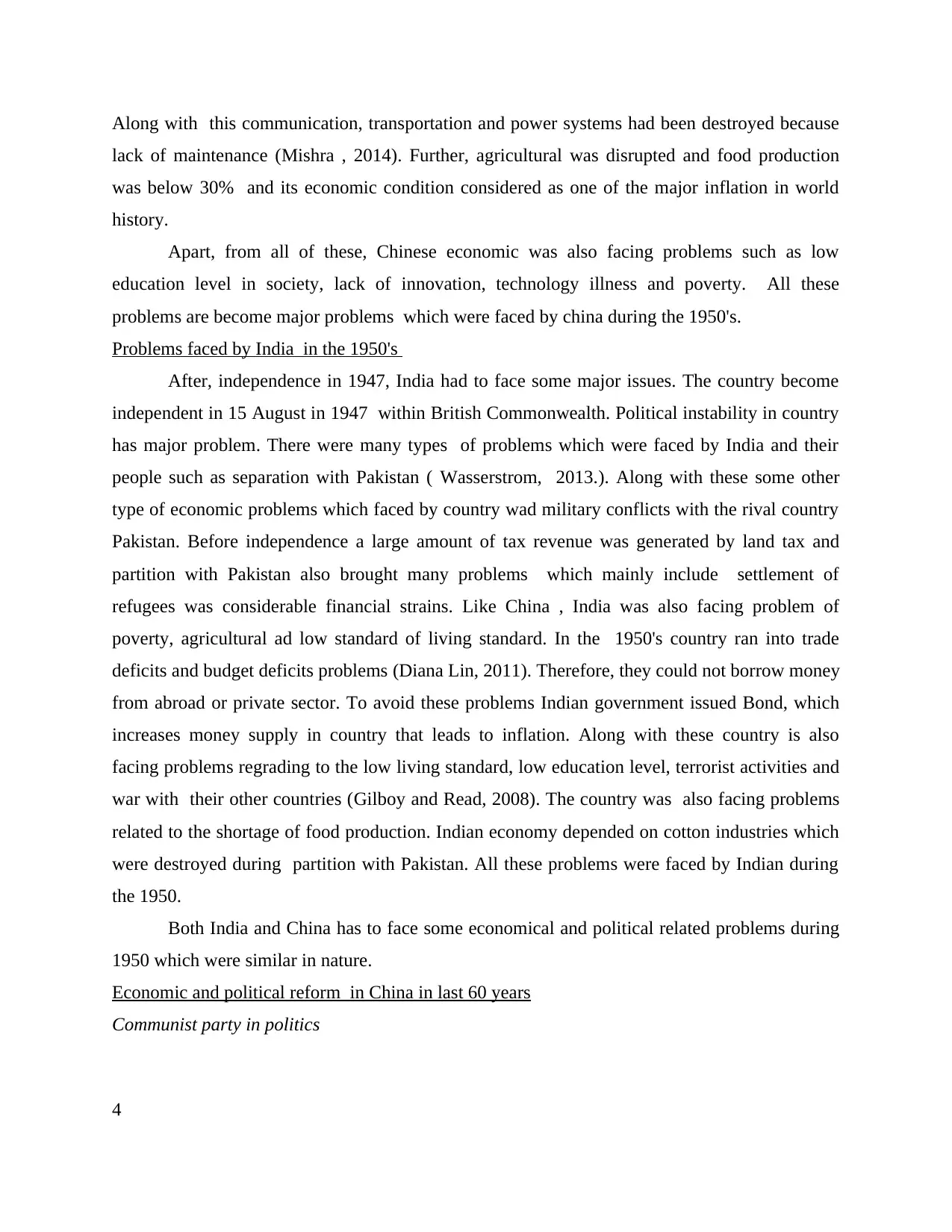
Along with this communication, transportation and power systems had been destroyed because
lack of maintenance (Mishra , 2014). Further, agricultural was disrupted and food production
was below 30% and its economic condition considered as one of the major inflation in world
history.
Apart, from all of these, Chinese economic was also facing problems such as low
education level in society, lack of innovation, technology illness and poverty. All these
problems are become major problems which were faced by china during the 1950's.
Problems faced by India in the 1950's
After, independence in 1947, India had to face some major issues. The country become
independent in 15 August in 1947 within British Commonwealth. Political instability in country
has major problem. There were many types of problems which were faced by India and their
people such as separation with Pakistan ( Wasserstrom, 2013.). Along with these some other
type of economic problems which faced by country wad military conflicts with the rival country
Pakistan. Before independence a large amount of tax revenue was generated by land tax and
partition with Pakistan also brought many problems which mainly include settlement of
refugees was considerable financial strains. Like China , India was also facing problem of
poverty, agricultural ad low standard of living standard. In the 1950's country ran into trade
deficits and budget deficits problems (Diana Lin, 2011). Therefore, they could not borrow money
from abroad or private sector. To avoid these problems Indian government issued Bond, which
increases money supply in country that leads to inflation. Along with these country is also
facing problems regrading to the low living standard, low education level, terrorist activities and
war with their other countries (Gilboy and Read, 2008). The country was also facing problems
related to the shortage of food production. Indian economy depended on cotton industries which
were destroyed during partition with Pakistan. All these problems were faced by Indian during
the 1950.
Both India and China has to face some economical and political related problems during
1950 which were similar in nature.
Economic and political reform in China in last 60 years
Communist party in politics
4
lack of maintenance (Mishra , 2014). Further, agricultural was disrupted and food production
was below 30% and its economic condition considered as one of the major inflation in world
history.
Apart, from all of these, Chinese economic was also facing problems such as low
education level in society, lack of innovation, technology illness and poverty. All these
problems are become major problems which were faced by china during the 1950's.
Problems faced by India in the 1950's
After, independence in 1947, India had to face some major issues. The country become
independent in 15 August in 1947 within British Commonwealth. Political instability in country
has major problem. There were many types of problems which were faced by India and their
people such as separation with Pakistan ( Wasserstrom, 2013.). Along with these some other
type of economic problems which faced by country wad military conflicts with the rival country
Pakistan. Before independence a large amount of tax revenue was generated by land tax and
partition with Pakistan also brought many problems which mainly include settlement of
refugees was considerable financial strains. Like China , India was also facing problem of
poverty, agricultural ad low standard of living standard. In the 1950's country ran into trade
deficits and budget deficits problems (Diana Lin, 2011). Therefore, they could not borrow money
from abroad or private sector. To avoid these problems Indian government issued Bond, which
increases money supply in country that leads to inflation. Along with these country is also
facing problems regrading to the low living standard, low education level, terrorist activities and
war with their other countries (Gilboy and Read, 2008). The country was also facing problems
related to the shortage of food production. Indian economy depended on cotton industries which
were destroyed during partition with Pakistan. All these problems were faced by Indian during
the 1950.
Both India and China has to face some economical and political related problems during
1950 which were similar in nature.
Economic and political reform in China in last 60 years
Communist party in politics
4
Paraphrase This Document
Need a fresh take? Get an instant paraphrase of this document with our AI Paraphraser
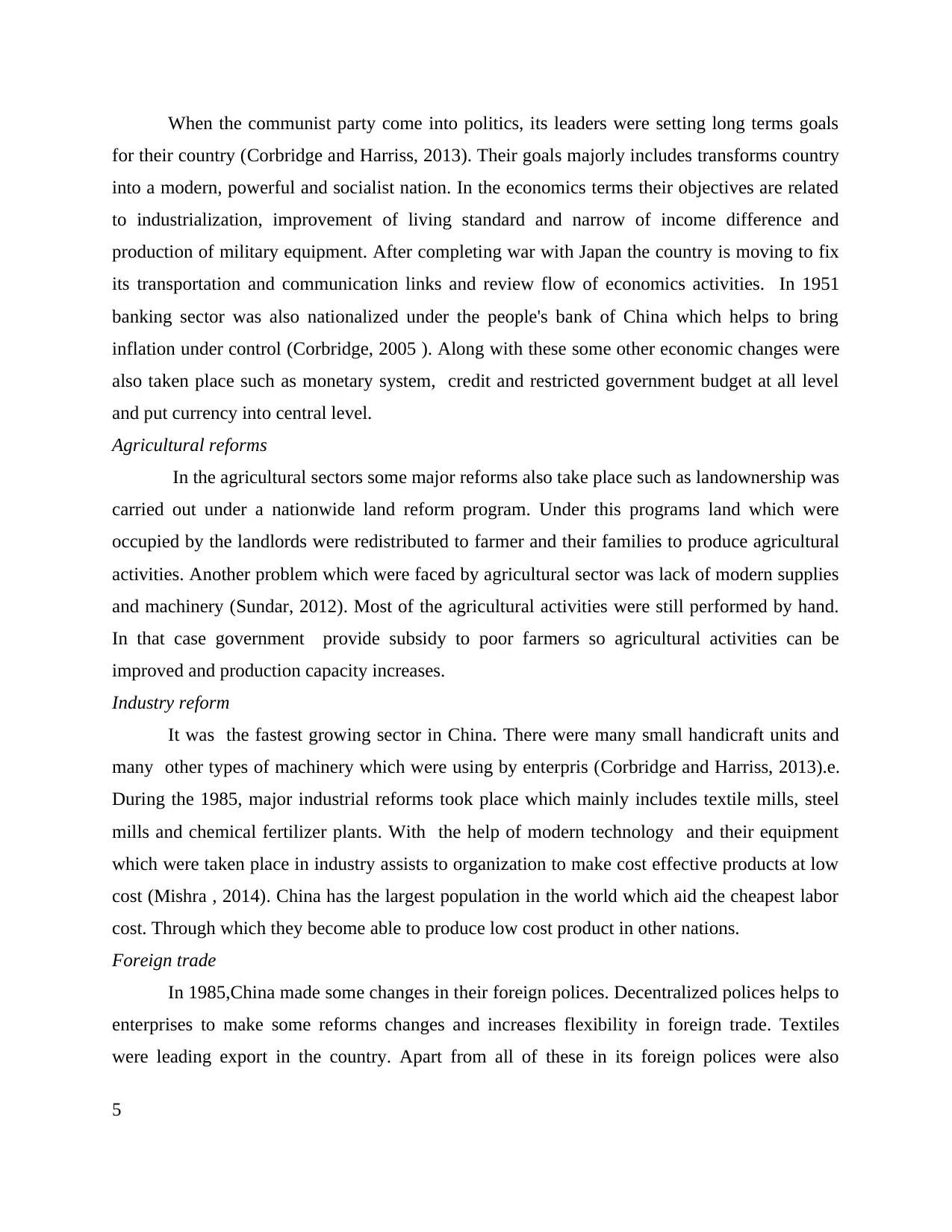
When the communist party come into politics, its leaders were setting long terms goals
for their country (Corbridge and Harriss, 2013). Their goals majorly includes transforms country
into a modern, powerful and socialist nation. In the economics terms their objectives are related
to industrialization, improvement of living standard and narrow of income difference and
production of military equipment. After completing war with Japan the country is moving to fix
its transportation and communication links and review flow of economics activities. In 1951
banking sector was also nationalized under the people's bank of China which helps to bring
inflation under control (Corbridge, 2005 ). Along with these some other economic changes were
also taken place such as monetary system, credit and restricted government budget at all level
and put currency into central level.
Agricultural reforms
In the agricultural sectors some major reforms also take place such as landownership was
carried out under a nationwide land reform program. Under this programs land which were
occupied by the landlords were redistributed to farmer and their families to produce agricultural
activities. Another problem which were faced by agricultural sector was lack of modern supplies
and machinery (Sundar, 2012). Most of the agricultural activities were still performed by hand.
In that case government provide subsidy to poor farmers so agricultural activities can be
improved and production capacity increases.
Industry reform
It was the fastest growing sector in China. There were many small handicraft units and
many other types of machinery which were using by enterpris (Corbridge and Harriss, 2013).e.
During the 1985, major industrial reforms took place which mainly includes textile mills, steel
mills and chemical fertilizer plants. With the help of modern technology and their equipment
which were taken place in industry assists to organization to make cost effective products at low
cost (Mishra , 2014). China has the largest population in the world which aid the cheapest labor
cost. Through which they become able to produce low cost product in other nations.
Foreign trade
In 1985,China made some changes in their foreign polices. Decentralized polices helps to
enterprises to make some reforms changes and increases flexibility in foreign trade. Textiles
were leading export in the country. Apart from all of these in its foreign polices were also
5
for their country (Corbridge and Harriss, 2013). Their goals majorly includes transforms country
into a modern, powerful and socialist nation. In the economics terms their objectives are related
to industrialization, improvement of living standard and narrow of income difference and
production of military equipment. After completing war with Japan the country is moving to fix
its transportation and communication links and review flow of economics activities. In 1951
banking sector was also nationalized under the people's bank of China which helps to bring
inflation under control (Corbridge, 2005 ). Along with these some other economic changes were
also taken place such as monetary system, credit and restricted government budget at all level
and put currency into central level.
Agricultural reforms
In the agricultural sectors some major reforms also take place such as landownership was
carried out under a nationwide land reform program. Under this programs land which were
occupied by the landlords were redistributed to farmer and their families to produce agricultural
activities. Another problem which were faced by agricultural sector was lack of modern supplies
and machinery (Sundar, 2012). Most of the agricultural activities were still performed by hand.
In that case government provide subsidy to poor farmers so agricultural activities can be
improved and production capacity increases.
Industry reform
It was the fastest growing sector in China. There were many small handicraft units and
many other types of machinery which were using by enterpris (Corbridge and Harriss, 2013).e.
During the 1985, major industrial reforms took place which mainly includes textile mills, steel
mills and chemical fertilizer plants. With the help of modern technology and their equipment
which were taken place in industry assists to organization to make cost effective products at low
cost (Mishra , 2014). China has the largest population in the world which aid the cheapest labor
cost. Through which they become able to produce low cost product in other nations.
Foreign trade
In 1985,China made some changes in their foreign polices. Decentralized polices helps to
enterprises to make some reforms changes and increases flexibility in foreign trade. Textiles
were leading export in the country. Apart from all of these in its foreign polices were also
5
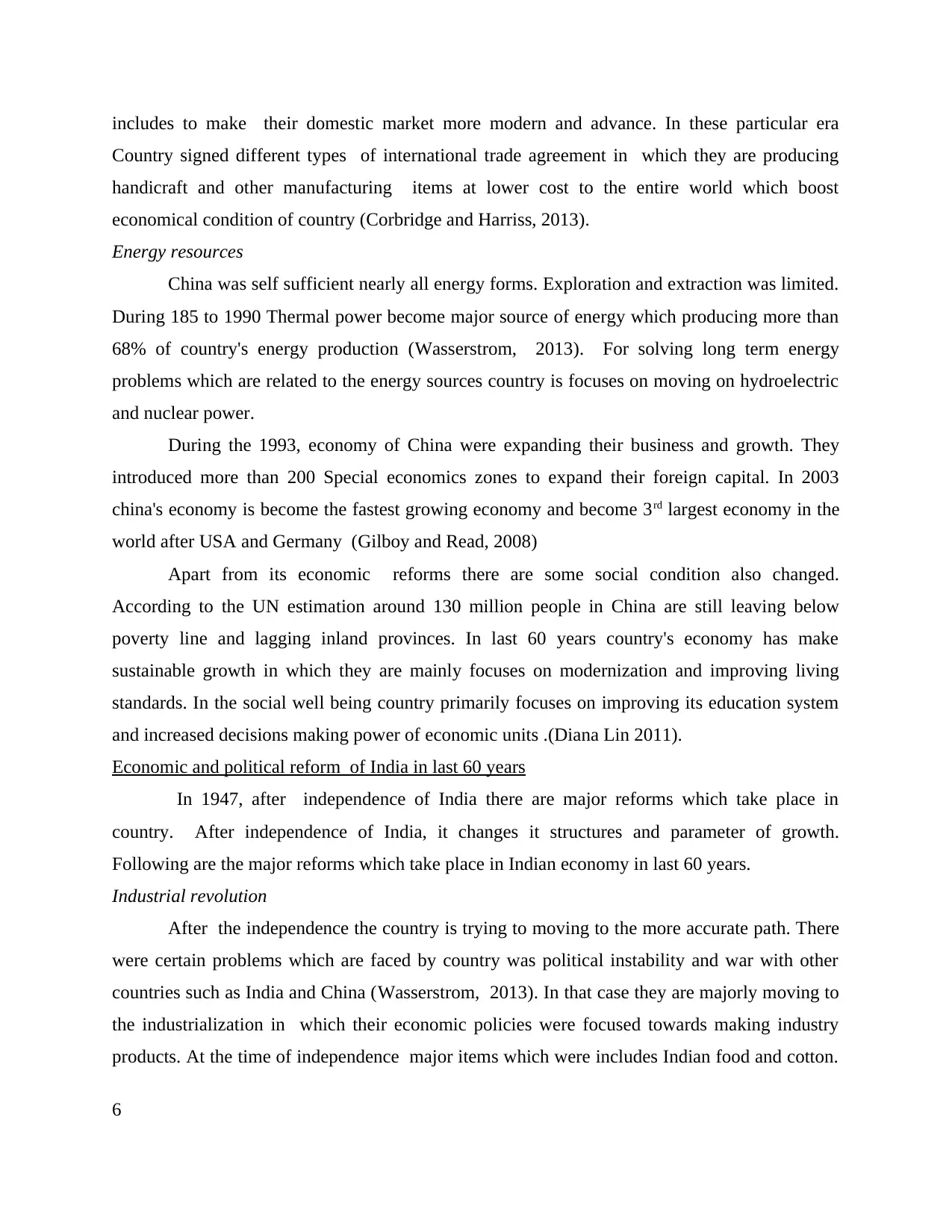
includes to make their domestic market more modern and advance. In these particular era
Country signed different types of international trade agreement in which they are producing
handicraft and other manufacturing items at lower cost to the entire world which boost
economical condition of country (Corbridge and Harriss, 2013).
Energy resources
China was self sufficient nearly all energy forms. Exploration and extraction was limited.
During 185 to 1990 Thermal power become major source of energy which producing more than
68% of country's energy production (Wasserstrom, 2013). For solving long term energy
problems which are related to the energy sources country is focuses on moving on hydroelectric
and nuclear power.
During the 1993, economy of China were expanding their business and growth. They
introduced more than 200 Special economics zones to expand their foreign capital. In 2003
china's economy is become the fastest growing economy and become 3rd largest economy in the
world after USA and Germany (Gilboy and Read, 2008)
Apart from its economic reforms there are some social condition also changed.
According to the UN estimation around 130 million people in China are still leaving below
poverty line and lagging inland provinces. In last 60 years country's economy has make
sustainable growth in which they are mainly focuses on modernization and improving living
standards. In the social well being country primarily focuses on improving its education system
and increased decisions making power of economic units .(Diana Lin 2011).
Economic and political reform of India in last 60 years
In 1947, after independence of India there are major reforms which take place in
country. After independence of India, it changes it structures and parameter of growth.
Following are the major reforms which take place in Indian economy in last 60 years.
Industrial revolution
After the independence the country is trying to moving to the more accurate path. There
were certain problems which are faced by country was political instability and war with other
countries such as India and China (Wasserstrom, 2013). In that case they are majorly moving to
the industrialization in which their economic policies were focused towards making industry
products. At the time of independence major items which were includes Indian food and cotton.
6
Country signed different types of international trade agreement in which they are producing
handicraft and other manufacturing items at lower cost to the entire world which boost
economical condition of country (Corbridge and Harriss, 2013).
Energy resources
China was self sufficient nearly all energy forms. Exploration and extraction was limited.
During 185 to 1990 Thermal power become major source of energy which producing more than
68% of country's energy production (Wasserstrom, 2013). For solving long term energy
problems which are related to the energy sources country is focuses on moving on hydroelectric
and nuclear power.
During the 1993, economy of China were expanding their business and growth. They
introduced more than 200 Special economics zones to expand their foreign capital. In 2003
china's economy is become the fastest growing economy and become 3rd largest economy in the
world after USA and Germany (Gilboy and Read, 2008)
Apart from its economic reforms there are some social condition also changed.
According to the UN estimation around 130 million people in China are still leaving below
poverty line and lagging inland provinces. In last 60 years country's economy has make
sustainable growth in which they are mainly focuses on modernization and improving living
standards. In the social well being country primarily focuses on improving its education system
and increased decisions making power of economic units .(Diana Lin 2011).
Economic and political reform of India in last 60 years
In 1947, after independence of India there are major reforms which take place in
country. After independence of India, it changes it structures and parameter of growth.
Following are the major reforms which take place in Indian economy in last 60 years.
Industrial revolution
After the independence the country is trying to moving to the more accurate path. There
were certain problems which are faced by country was political instability and war with other
countries such as India and China (Wasserstrom, 2013). In that case they are majorly moving to
the industrialization in which their economic policies were focused towards making industry
products. At the time of independence major items which were includes Indian food and cotton.
6
⊘ This is a preview!⊘
Do you want full access?
Subscribe today to unlock all pages.

Trusted by 1+ million students worldwide
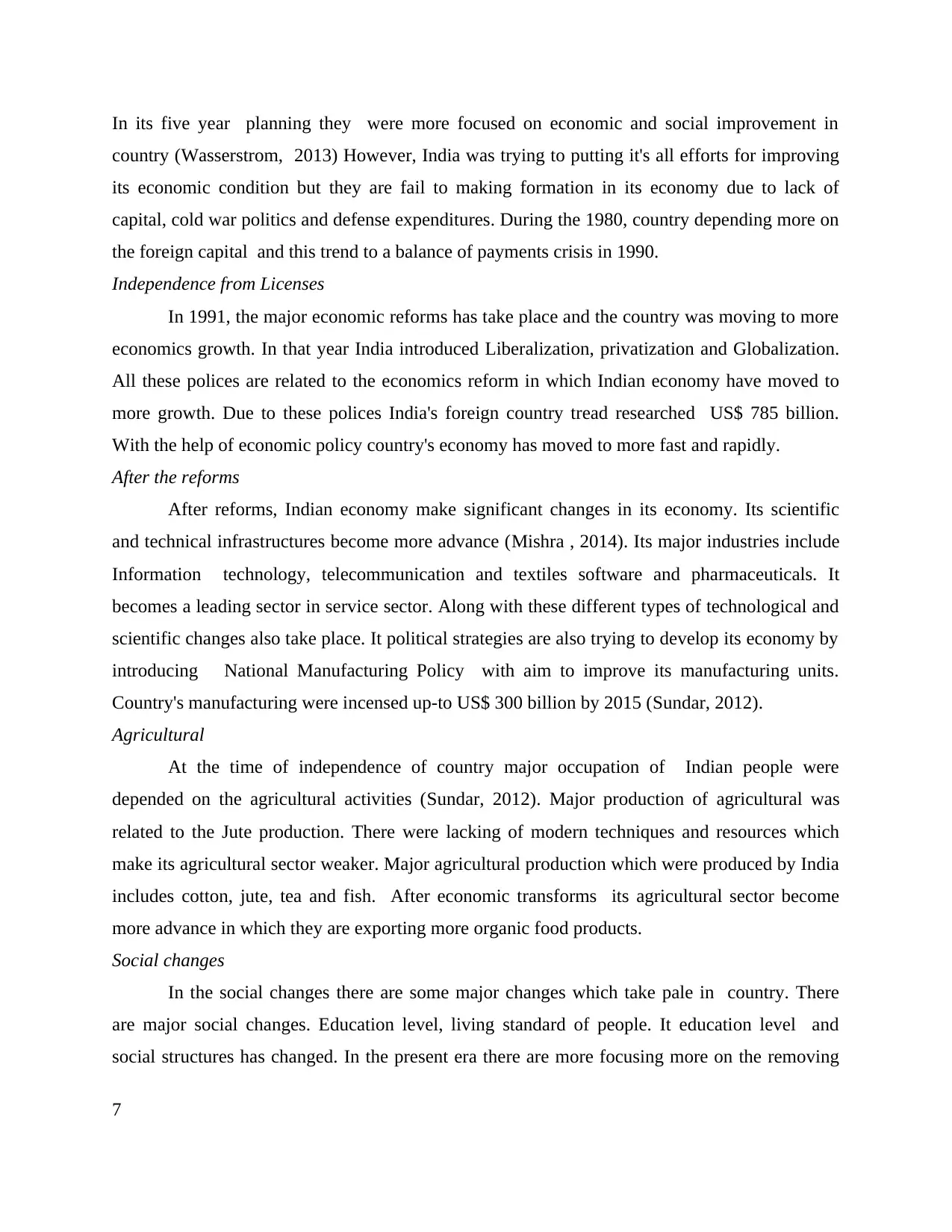
In its five year planning they were more focused on economic and social improvement in
country (Wasserstrom, 2013) However, India was trying to putting it's all efforts for improving
its economic condition but they are fail to making formation in its economy due to lack of
capital, cold war politics and defense expenditures. During the 1980, country depending more on
the foreign capital and this trend to a balance of payments crisis in 1990.
Independence from Licenses
In 1991, the major economic reforms has take place and the country was moving to more
economics growth. In that year India introduced Liberalization, privatization and Globalization.
All these polices are related to the economics reform in which Indian economy have moved to
more growth. Due to these polices India's foreign country tread researched US$ 785 billion.
With the help of economic policy country's economy has moved to more fast and rapidly.
After the reforms
After reforms, Indian economy make significant changes in its economy. Its scientific
and technical infrastructures become more advance (Mishra , 2014). Its major industries include
Information technology, telecommunication and textiles software and pharmaceuticals. It
becomes a leading sector in service sector. Along with these different types of technological and
scientific changes also take place. It political strategies are also trying to develop its economy by
introducing National Manufacturing Policy with aim to improve its manufacturing units.
Country's manufacturing were incensed up-to US$ 300 billion by 2015 (Sundar, 2012).
Agricultural
At the time of independence of country major occupation of Indian people were
depended on the agricultural activities (Sundar, 2012). Major production of agricultural was
related to the Jute production. There were lacking of modern techniques and resources which
make its agricultural sector weaker. Major agricultural production which were produced by India
includes cotton, jute, tea and fish. After economic transforms its agricultural sector become
more advance in which they are exporting more organic food products.
Social changes
In the social changes there are some major changes which take pale in country. There
are major social changes. Education level, living standard of people. It education level and
social structures has changed. In the present era there are more focusing more on the removing
7
country (Wasserstrom, 2013) However, India was trying to putting it's all efforts for improving
its economic condition but they are fail to making formation in its economy due to lack of
capital, cold war politics and defense expenditures. During the 1980, country depending more on
the foreign capital and this trend to a balance of payments crisis in 1990.
Independence from Licenses
In 1991, the major economic reforms has take place and the country was moving to more
economics growth. In that year India introduced Liberalization, privatization and Globalization.
All these polices are related to the economics reform in which Indian economy have moved to
more growth. Due to these polices India's foreign country tread researched US$ 785 billion.
With the help of economic policy country's economy has moved to more fast and rapidly.
After the reforms
After reforms, Indian economy make significant changes in its economy. Its scientific
and technical infrastructures become more advance (Mishra , 2014). Its major industries include
Information technology, telecommunication and textiles software and pharmaceuticals. It
becomes a leading sector in service sector. Along with these different types of technological and
scientific changes also take place. It political strategies are also trying to develop its economy by
introducing National Manufacturing Policy with aim to improve its manufacturing units.
Country's manufacturing were incensed up-to US$ 300 billion by 2015 (Sundar, 2012).
Agricultural
At the time of independence of country major occupation of Indian people were
depended on the agricultural activities (Sundar, 2012). Major production of agricultural was
related to the Jute production. There were lacking of modern techniques and resources which
make its agricultural sector weaker. Major agricultural production which were produced by India
includes cotton, jute, tea and fish. After economic transforms its agricultural sector become
more advance in which they are exporting more organic food products.
Social changes
In the social changes there are some major changes which take pale in country. There
are major social changes. Education level, living standard of people. It education level and
social structures has changed. In the present era there are more focusing more on the removing
7
Paraphrase This Document
Need a fresh take? Get an instant paraphrase of this document with our AI Paraphraser
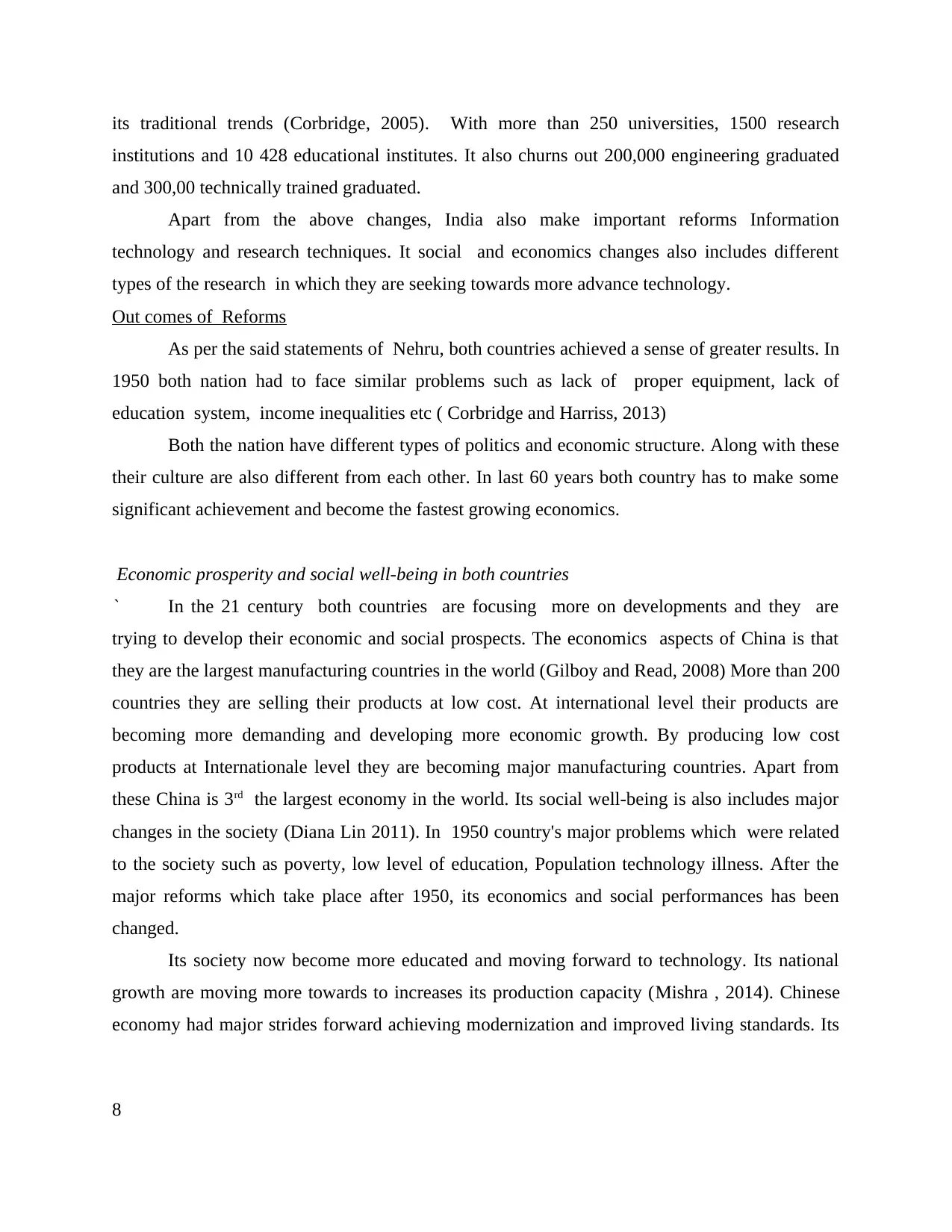
its traditional trends (Corbridge, 2005). With more than 250 universities, 1500 research
institutions and 10 428 educational institutes. It also churns out 200,000 engineering graduated
and 300,00 technically trained graduated.
Apart from the above changes, India also make important reforms Information
technology and research techniques. It social and economics changes also includes different
types of the research in which they are seeking towards more advance technology.
Out comes of Reforms
As per the said statements of Nehru, both countries achieved a sense of greater results. In
1950 both nation had to face similar problems such as lack of proper equipment, lack of
education system, income inequalities etc ( Corbridge and Harriss, 2013)
Both the nation have different types of politics and economic structure. Along with these
their culture are also different from each other. In last 60 years both country has to make some
significant achievement and become the fastest growing economics.
Economic prosperity and social well-being in both countries
` In the 21 century both countries are focusing more on developments and they are
trying to develop their economic and social prospects. The economics aspects of China is that
they are the largest manufacturing countries in the world (Gilboy and Read, 2008) More than 200
countries they are selling their products at low cost. At international level their products are
becoming more demanding and developing more economic growth. By producing low cost
products at Internationale level they are becoming major manufacturing countries. Apart from
these China is 3rd the largest economy in the world. Its social well-being is also includes major
changes in the society (Diana Lin 2011). In 1950 country's major problems which were related
to the society such as poverty, low level of education, Population technology illness. After the
major reforms which take place after 1950, its economics and social performances has been
changed.
Its society now become more educated and moving forward to technology. Its national
growth are moving more towards to increases its production capacity (Mishra , 2014). Chinese
economy had major strides forward achieving modernization and improved living standards. Its
8
institutions and 10 428 educational institutes. It also churns out 200,000 engineering graduated
and 300,00 technically trained graduated.
Apart from the above changes, India also make important reforms Information
technology and research techniques. It social and economics changes also includes different
types of the research in which they are seeking towards more advance technology.
Out comes of Reforms
As per the said statements of Nehru, both countries achieved a sense of greater results. In
1950 both nation had to face similar problems such as lack of proper equipment, lack of
education system, income inequalities etc ( Corbridge and Harriss, 2013)
Both the nation have different types of politics and economic structure. Along with these
their culture are also different from each other. In last 60 years both country has to make some
significant achievement and become the fastest growing economics.
Economic prosperity and social well-being in both countries
` In the 21 century both countries are focusing more on developments and they are
trying to develop their economic and social prospects. The economics aspects of China is that
they are the largest manufacturing countries in the world (Gilboy and Read, 2008) More than 200
countries they are selling their products at low cost. At international level their products are
becoming more demanding and developing more economic growth. By producing low cost
products at Internationale level they are becoming major manufacturing countries. Apart from
these China is 3rd the largest economy in the world. Its social well-being is also includes major
changes in the society (Diana Lin 2011). In 1950 country's major problems which were related
to the society such as poverty, low level of education, Population technology illness. After the
major reforms which take place after 1950, its economics and social performances has been
changed.
Its society now become more educated and moving forward to technology. Its national
growth are moving more towards to increases its production capacity (Mishra , 2014). Chinese
economy had major strides forward achieving modernization and improved living standards. Its
8
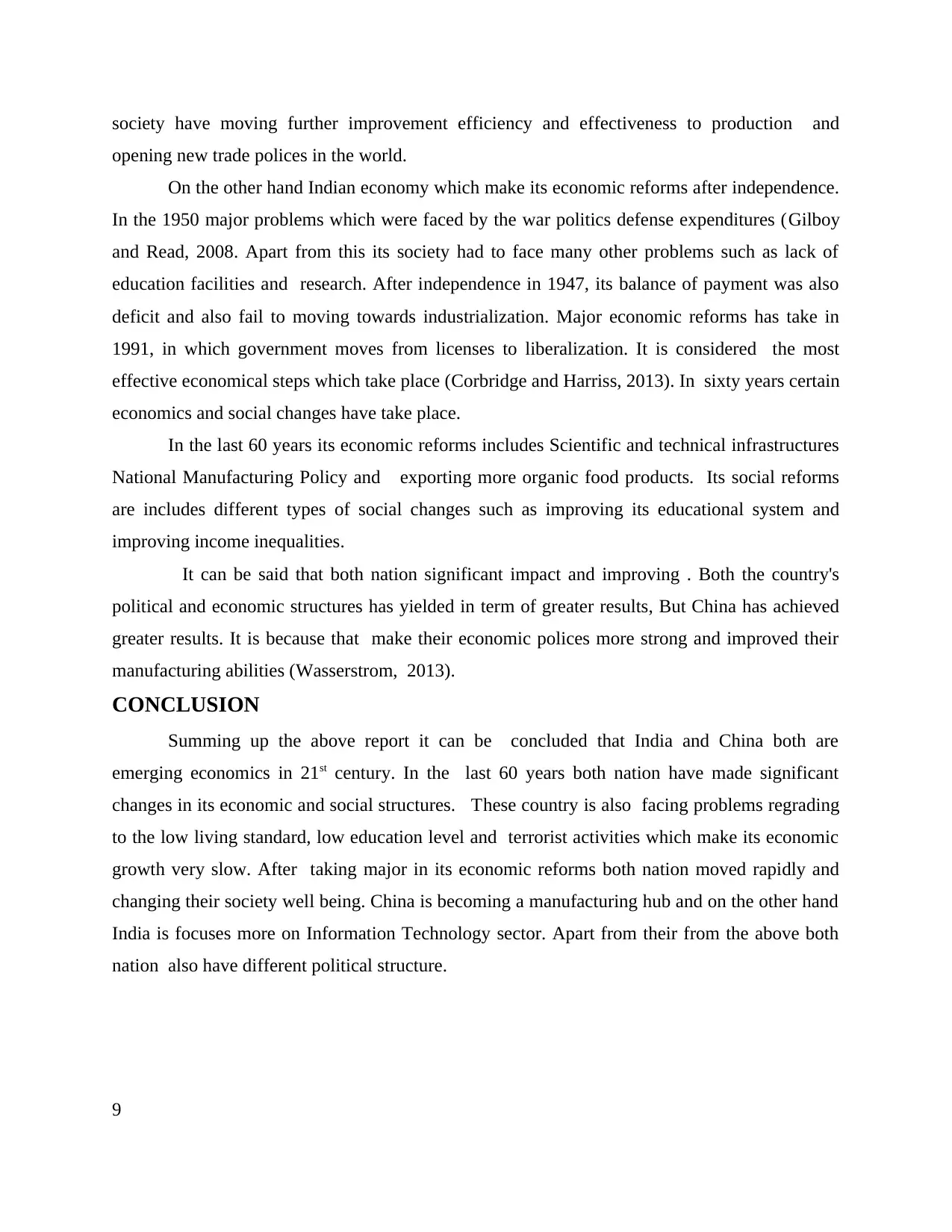
society have moving further improvement efficiency and effectiveness to production and
opening new trade polices in the world.
On the other hand Indian economy which make its economic reforms after independence.
In the 1950 major problems which were faced by the war politics defense expenditures (Gilboy
and Read, 2008. Apart from this its society had to face many other problems such as lack of
education facilities and research. After independence in 1947, its balance of payment was also
deficit and also fail to moving towards industrialization. Major economic reforms has take in
1991, in which government moves from licenses to liberalization. It is considered the most
effective economical steps which take place (Corbridge and Harriss, 2013). In sixty years certain
economics and social changes have take place.
In the last 60 years its economic reforms includes Scientific and technical infrastructures
National Manufacturing Policy and exporting more organic food products. Its social reforms
are includes different types of social changes such as improving its educational system and
improving income inequalities.
It can be said that both nation significant impact and improving . Both the country's
political and economic structures has yielded in term of greater results, But China has achieved
greater results. It is because that make their economic polices more strong and improved their
manufacturing abilities (Wasserstrom, 2013).
CONCLUSION
Summing up the above report it can be concluded that India and China both are
emerging economics in 21st century. In the last 60 years both nation have made significant
changes in its economic and social structures. These country is also facing problems regrading
to the low living standard, low education level and terrorist activities which make its economic
growth very slow. After taking major in its economic reforms both nation moved rapidly and
changing their society well being. China is becoming a manufacturing hub and on the other hand
India is focuses more on Information Technology sector. Apart from their from the above both
nation also have different political structure.
9
opening new trade polices in the world.
On the other hand Indian economy which make its economic reforms after independence.
In the 1950 major problems which were faced by the war politics defense expenditures (Gilboy
and Read, 2008. Apart from this its society had to face many other problems such as lack of
education facilities and research. After independence in 1947, its balance of payment was also
deficit and also fail to moving towards industrialization. Major economic reforms has take in
1991, in which government moves from licenses to liberalization. It is considered the most
effective economical steps which take place (Corbridge and Harriss, 2013). In sixty years certain
economics and social changes have take place.
In the last 60 years its economic reforms includes Scientific and technical infrastructures
National Manufacturing Policy and exporting more organic food products. Its social reforms
are includes different types of social changes such as improving its educational system and
improving income inequalities.
It can be said that both nation significant impact and improving . Both the country's
political and economic structures has yielded in term of greater results, But China has achieved
greater results. It is because that make their economic polices more strong and improved their
manufacturing abilities (Wasserstrom, 2013).
CONCLUSION
Summing up the above report it can be concluded that India and China both are
emerging economics in 21st century. In the last 60 years both nation have made significant
changes in its economic and social structures. These country is also facing problems regrading
to the low living standard, low education level and terrorist activities which make its economic
growth very slow. After taking major in its economic reforms both nation moved rapidly and
changing their society well being. China is becoming a manufacturing hub and on the other hand
India is focuses more on Information Technology sector. Apart from their from the above both
nation also have different political structure.
9
⊘ This is a preview!⊘
Do you want full access?
Subscribe today to unlock all pages.

Trusted by 1+ million students worldwide
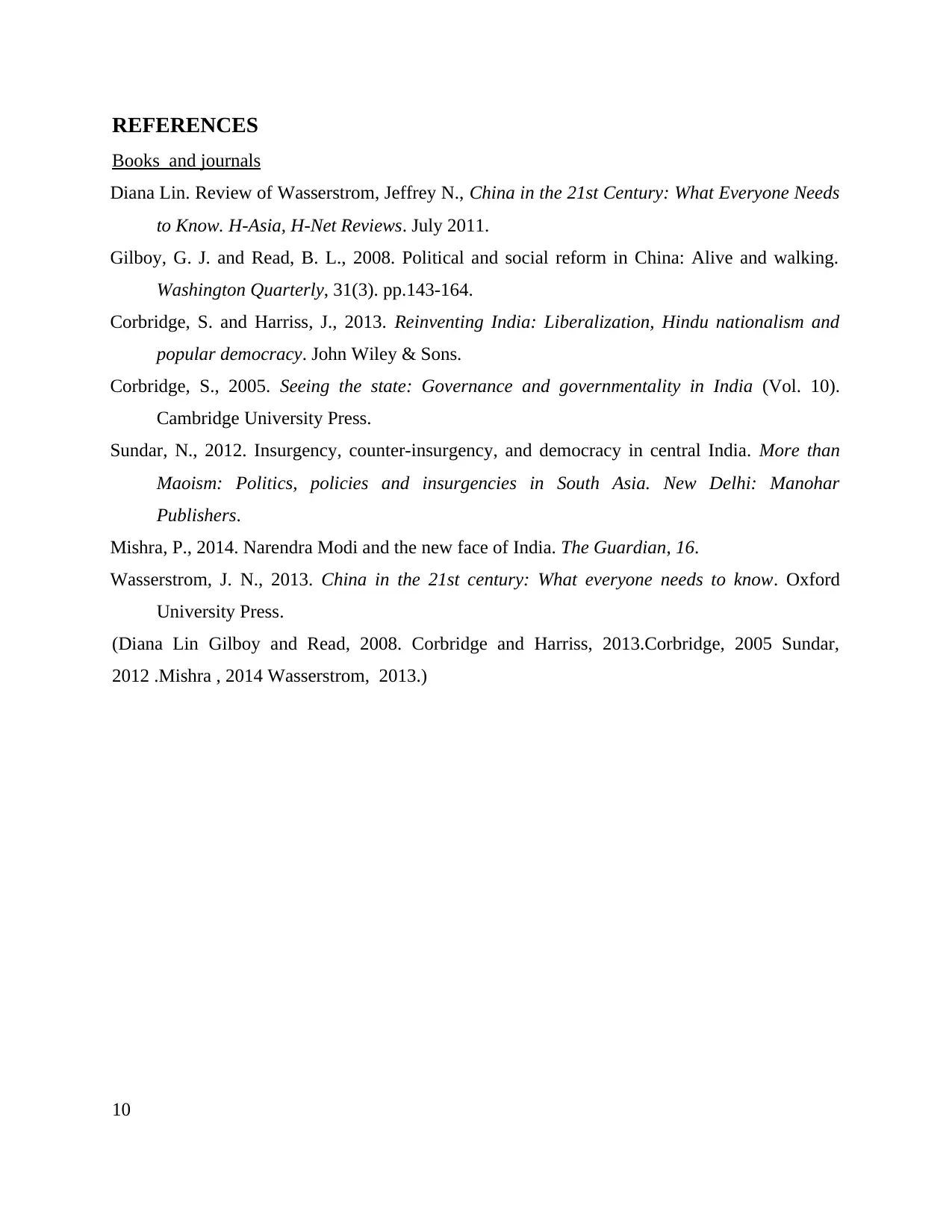
REFERENCES
Books and journals
Diana Lin. Review of Wasserstrom, Jeffrey N., China in the 21st Century: What Everyone Needs
to Know. H-Asia, H-Net Reviews. July 2011.
Gilboy, G. J. and Read, B. L., 2008. Political and social reform in China: Alive and walking.
Washington Quarterly, 31(3). pp.143-164.
Corbridge, S. and Harriss, J., 2013. Reinventing India: Liberalization, Hindu nationalism and
popular democracy. John Wiley & Sons.
Corbridge, S., 2005. Seeing the state: Governance and governmentality in India (Vol. 10).
Cambridge University Press.
Sundar, N., 2012. Insurgency, counter-insurgency, and democracy in central India. More than
Maoism: Politics, policies and insurgencies in South Asia. New Delhi: Manohar
Publishers.
Mishra, P., 2014. Narendra Modi and the new face of India. The Guardian, 16.
Wasserstrom, J. N., 2013. China in the 21st century: What everyone needs to know. Oxford
University Press.
(Diana Lin Gilboy and Read, 2008. Corbridge and Harriss, 2013.Corbridge, 2005 Sundar,
2012 .Mishra , 2014 Wasserstrom, 2013.)
10
Books and journals
Diana Lin. Review of Wasserstrom, Jeffrey N., China in the 21st Century: What Everyone Needs
to Know. H-Asia, H-Net Reviews. July 2011.
Gilboy, G. J. and Read, B. L., 2008. Political and social reform in China: Alive and walking.
Washington Quarterly, 31(3). pp.143-164.
Corbridge, S. and Harriss, J., 2013. Reinventing India: Liberalization, Hindu nationalism and
popular democracy. John Wiley & Sons.
Corbridge, S., 2005. Seeing the state: Governance and governmentality in India (Vol. 10).
Cambridge University Press.
Sundar, N., 2012. Insurgency, counter-insurgency, and democracy in central India. More than
Maoism: Politics, policies and insurgencies in South Asia. New Delhi: Manohar
Publishers.
Mishra, P., 2014. Narendra Modi and the new face of India. The Guardian, 16.
Wasserstrom, J. N., 2013. China in the 21st century: What everyone needs to know. Oxford
University Press.
(Diana Lin Gilboy and Read, 2008. Corbridge and Harriss, 2013.Corbridge, 2005 Sundar,
2012 .Mishra , 2014 Wasserstrom, 2013.)
10
1 out of 10
Related Documents
Your All-in-One AI-Powered Toolkit for Academic Success.
+13062052269
info@desklib.com
Available 24*7 on WhatsApp / Email
![[object Object]](/_next/static/media/star-bottom.7253800d.svg)
Unlock your academic potential
Copyright © 2020–2025 A2Z Services. All Rights Reserved. Developed and managed by ZUCOL.





